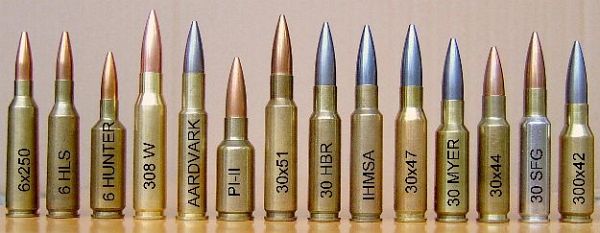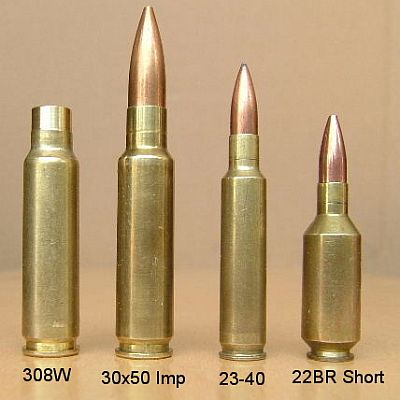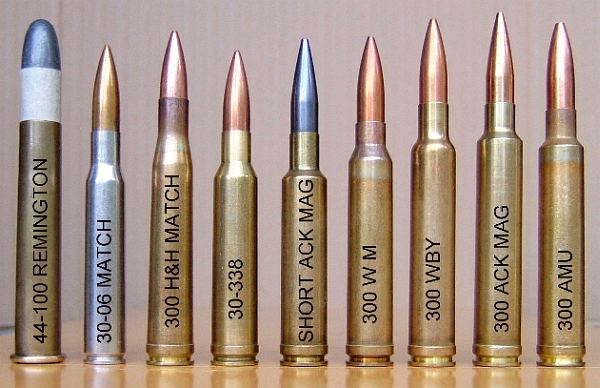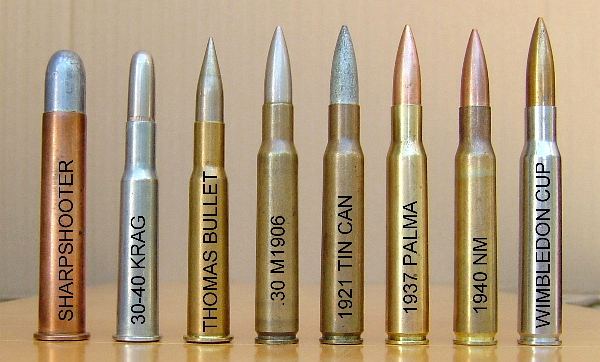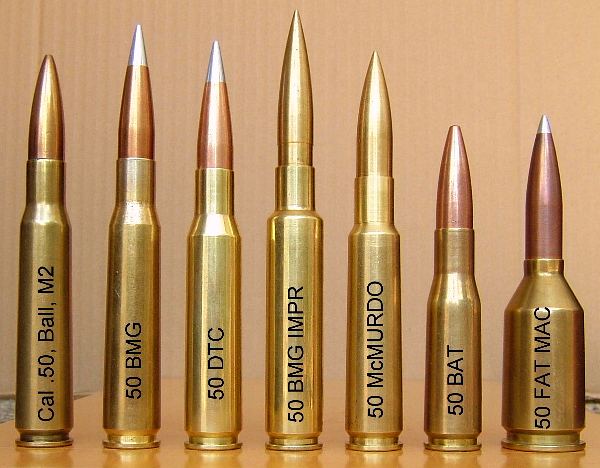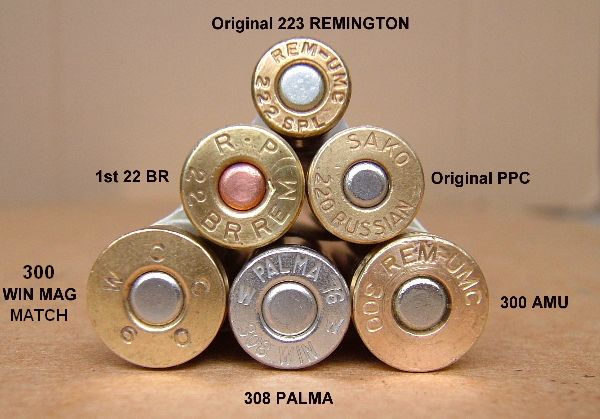Competition Cartridges
A Brief History of Cartridge Design by Cheechako
Introduction--The .222 Remington
I am a competition shooter, a cartridge collector, and an amateur historian, not necessarily in that order. I thought that this Forum would be a good place to share a little of my interests with you by describing a few of the competition cartridges from my collection and giving a little history of how they came to be. I'll start with one that everybody knows, the .222 Remington.
In 1948 Remington introduced their new Model 722 rifles. The first “short action” Remington, it was chambered in 300 Savage and 257 Roberts and advertised as a new, lighter weight, big game rifle. But even before the first 722 found its way to gun store shelves, Remington was looking at the rifle as the foundation for a new live-varmint cartridge, something that would fill the gap between the 22 Hornet and the 220 Swift. Rather than try to modify one of the existing cartridges, Remington R&D decided to develop a completely new case. The prototype looked very much like todays 221 Fireball. It was 1.450" long and loaded with a 48-grain soft-point bullet. Different primers, powders, and powder charges were tested for velocity and accuracy. But Mike Walker, the designer of the 722 action, thought the cartridge was too short to feed reliably through the 722 action and so he recommended a slightly longer case. With the redesigned cartridge in hand, he and F&S Gun Editor Warren Page set forth to test it in the field. They found the bullet to be too hard resulting in ricochets and unreliable expansion and recommended the weight be increased to 50 grains, the jacket thinned, and the velocity increased to 3200 fps. All three changes were adopted and the new .222 Remington was introduced in early 1950.
Both Page and Walker were Benchrest shooters and saw the potential of the new cartridge for 100 and 200-yard benchrest. It was first used in competition in 1951 and started winning everything in sight, dominating for more than 20 years. But there's not a Benchrest shooter alive who doesn't think a good cartridge can be made better and even it was wildcatted. Shown below are six cartridges from my collection. A .222 Prototype, a standard .222 Remington varmint load, a .222 Remington Benchrest load, and three wildcats, the 222-35, 222-40, and 222 Haney.
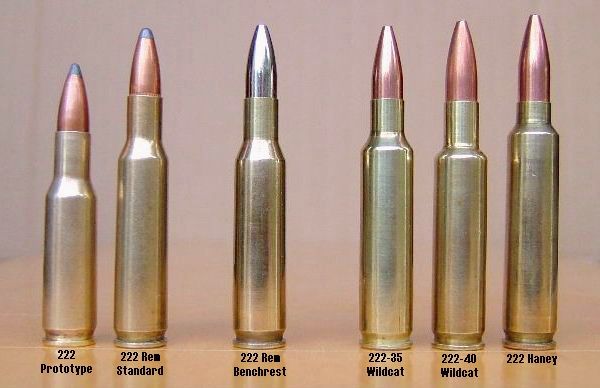
The 220 Russian and Derivatives
There can't be a benchrest shooter alive today who hasn't heard of the 220 Russian. After all, his PPC brass carries that very headstamp. Todays shooters almost exclusively use Lapua 220 Russian brass but anyone who was around before the 1990s will also recognize the Sako 220 Russian cases. Sako brass is what Dr. Lou Palmisano used for his very first PPC case and most benchrest shooters adopting the round in the 1970s and 80s used it too.
But how many shooters have actually seen a 220 Russian cartridge? I don't mean the brass made in Finland by Sako or Lapua, but a real 220 Russian made in Russia. Not too many, I'd say. And probably not many more know the story behind the origins of the 220 Russian.
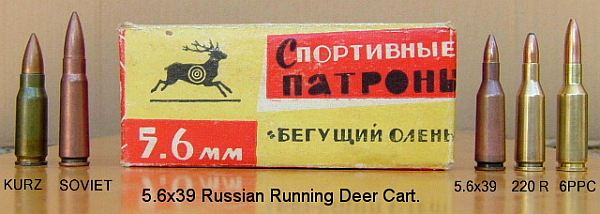
You might say that the 220 Russian was inspired by a cartridge that was inspired by another cartridge. For the beginning we have to go all the way back to 1942. In that year of World War II the German army first tested its new 7.92x33mm Kurz cartridge in actual combat against the Russian army. A shortened 8mm Mauser cartridge, the Kurz and the MP43 "assault rifle", or Sturmgewehr, caught everyone by surprise and the idea was quickly copied by the Russians themselves. By the war's end they had developed their own version of the assault rifle, the SKS, and later the AK and AKM. All used a cartridge very similar to the Kurz, one that is still used today, the 7.62x39mm Soviet.
During the Cold war there was very little exchange of information between the east and the west particularly when it came to weapons and ammunition. But we do know that by the late 1950s the Soviets had necked down the 7.62x39mm to 5.6mm (actually .221 bullet diameter) and were using it in a steel cased cartridge for running deer competition. With Finland so near, and with the 7.62x39mm being the official Finnish military cartridge, it was no surprise that the 5.6x39mm cartridge was also manufactured and used in that country. Both Sako and Lapua began production of the 5.6x39mm brass cartridges around 1965 and when imported to the United States they were headstamped SAKO 220 RUSSIAN and LAPUA 5.6x39 (later changed to LAPUA 220 RUSSIAN).
The Origins of the .308 Winchester
Even as World War II was still being fought and billions of rounds of 30-06 ammunition were being manufactured in arsenals across the country, the US Army began looking toward a new generation of small arms. More specifically they envisioned a new “light rifle” to take the place of the 30 Carbine and M1 Garand, firing a smaller cartridge but still maintaining the range and power of the 30-06.
In 1944 the Chief of Ordnance instructed the Frankford Arsenal to develop such a round. The Arsenal bought a supply of commercial 300 Savage brass from both Winchester and Remington and assembled them into test cartridges to determine pressures, velocities, and appropriate powders and primers. Once it was established that the project was feasible the Arsenal produced 10,000 new cases for further development and designated the new cartridge as the T-65. Over the course of the next 5 years the cartridge went through several design changes including neck length, shoulder angle, and case length. The final design was approved in 1949 and continued in use until August 1954 when it was standardized as the 7.62 x 51 NATO. In 1952 the Chief of Ordnance gave Winchester permission to use the case commercially . Winchester first called the new cartridge the 30-80 WCF but the name was quickly changed to what we know it as today, the 308 Winchester.
Adoption of any cartridge by the military means almost immediate use in competition. Even before adoption by NATO, the 308 National Match ammunition was being manufactured by the Lake City Arsenal for use in Service Rifle matches. Palma competition requires the use of the 308 cartridge loaded with a special 155 grain Palma Hollow point bullet. Benchrest shooters found the round to be competitively accurate although the substantial recoil limited it’s use almost exclusively to Heavy Bench or Unlimited Class rifles. Long Range benchrest shooters use the 308 in competition with long, heavy VLD bullets. But where the 308 case excels in competition is in the various wildcats of every imaginable size and shape, so numerous that they will be left for another chapter.
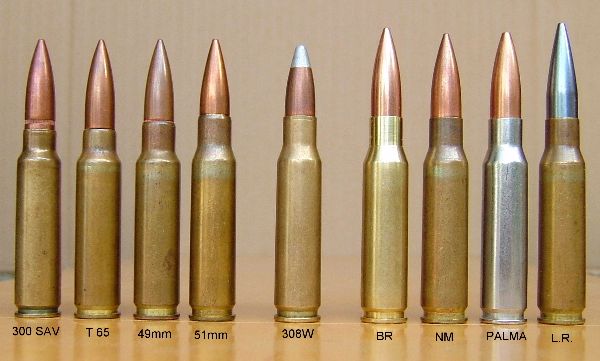
222 Rem Magnum and Derivatives
If you've followed my threads on Competition Cartridges you may have noticed a trend. Does it seem to you that many have U.S. military connections? Well you aren’t imagining it because it’s true. The one that follows is no exception.
In the early 1950s, Springfield Armory envisioned a small caliber, light infantry weapon for the future. In a joint effort with the Aberdeen Proving Ground and Remington Arms, they designed and constructed a couple of custom rifles and a quantity of ammunition for testing. Essentially a longer version of the brand new 222 Remington, the cartridge was unofficially called the “22 Special”. Remington used a conventional 55-grain SP hunting type bullet for the tests. Results were very encouraging.
But during this same time, Frankford Arsenal was developing a short and light 30-caliber weapon system and cartridge that it hoped to sell to NATO countries. (See my thread on the origins of the 308 Winchester). Other NATO members favored a small caliber weapon and the Army was fearful that the 22 Special would compromise their push for the 30 caliber and so they instructed Springfield Armory to abandon their project. Since Remington had been a cooperative in the project they were given permission to market the new cartridge commercially if they so wished. They did eventually, and today we know it as the .222 Remington Magnum.
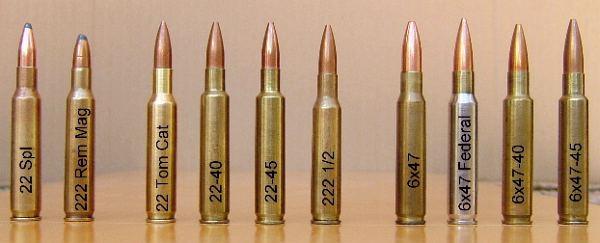
Any new cartridge is an automatic candidate for wildcatting and the .222 Remington Magnum was no exception. Even though the .222 Remington was able to deliver all the goods in short-range Benchrest, there were shooters who thought they could do better. (Sound familiar?) There isn’t much that can be done to a cartridge the size of the .222 Remington Magnum but all of it was done. The shoulder angle was increased to 30 (22 Tom Cat), then 40 (22-40), then 45 degrees (22-45). When that limit was reached they went in the other direction, shortened it and called it the 222 ½. Since the Sporter Class required a cartridge not less than .23 caliber, the .222 Remington Magnum was simply expanded to .243 and the original 6x47 was born (not to be confused with 6x47 Swiss Match). It too was “improved” by increasing the shoulder angle to 40 (6x47-40) and then 45 degrees (6x47-45).
In the end, the only truly successful competition cartridge based on the 222 Remington Magnum was the original 6x47. Federal actually produced new, nickeled brass with a 6x47 headstamp. But it was only a few years until the newfangled PPC cartridges appeared and all the 222 Remington Magnum based cartridges became a part of ancient history. And here they are.
Cont'd.
A Brief History of Cartridge Design by Cheechako
Introduction--The .222 Remington
I am a competition shooter, a cartridge collector, and an amateur historian, not necessarily in that order. I thought that this Forum would be a good place to share a little of my interests with you by describing a few of the competition cartridges from my collection and giving a little history of how they came to be. I'll start with one that everybody knows, the .222 Remington.
In 1948 Remington introduced their new Model 722 rifles. The first “short action” Remington, it was chambered in 300 Savage and 257 Roberts and advertised as a new, lighter weight, big game rifle. But even before the first 722 found its way to gun store shelves, Remington was looking at the rifle as the foundation for a new live-varmint cartridge, something that would fill the gap between the 22 Hornet and the 220 Swift. Rather than try to modify one of the existing cartridges, Remington R&D decided to develop a completely new case. The prototype looked very much like todays 221 Fireball. It was 1.450" long and loaded with a 48-grain soft-point bullet. Different primers, powders, and powder charges were tested for velocity and accuracy. But Mike Walker, the designer of the 722 action, thought the cartridge was too short to feed reliably through the 722 action and so he recommended a slightly longer case. With the redesigned cartridge in hand, he and F&S Gun Editor Warren Page set forth to test it in the field. They found the bullet to be too hard resulting in ricochets and unreliable expansion and recommended the weight be increased to 50 grains, the jacket thinned, and the velocity increased to 3200 fps. All three changes were adopted and the new .222 Remington was introduced in early 1950.
Both Page and Walker were Benchrest shooters and saw the potential of the new cartridge for 100 and 200-yard benchrest. It was first used in competition in 1951 and started winning everything in sight, dominating for more than 20 years. But there's not a Benchrest shooter alive who doesn't think a good cartridge can be made better and even it was wildcatted. Shown below are six cartridges from my collection. A .222 Prototype, a standard .222 Remington varmint load, a .222 Remington Benchrest load, and three wildcats, the 222-35, 222-40, and 222 Haney.

The 220 Russian and Derivatives
There can't be a benchrest shooter alive today who hasn't heard of the 220 Russian. After all, his PPC brass carries that very headstamp. Todays shooters almost exclusively use Lapua 220 Russian brass but anyone who was around before the 1990s will also recognize the Sako 220 Russian cases. Sako brass is what Dr. Lou Palmisano used for his very first PPC case and most benchrest shooters adopting the round in the 1970s and 80s used it too.
But how many shooters have actually seen a 220 Russian cartridge? I don't mean the brass made in Finland by Sako or Lapua, but a real 220 Russian made in Russia. Not too many, I'd say. And probably not many more know the story behind the origins of the 220 Russian.

Pictured above are a 7.92x33mm Kurz, a 7.62x39mm Soviet, an original box of 5.6x39mm Russian ammunition, a steel-cased 5.6x39mm Russian cartridge, a brass cased Sako 220 Russian cartridge, and the descendant and end of the line for them all, a 6mm PPC.
You might say that the 220 Russian was inspired by a cartridge that was inspired by another cartridge. For the beginning we have to go all the way back to 1942. In that year of World War II the German army first tested its new 7.92x33mm Kurz cartridge in actual combat against the Russian army. A shortened 8mm Mauser cartridge, the Kurz and the MP43 "assault rifle", or Sturmgewehr, caught everyone by surprise and the idea was quickly copied by the Russians themselves. By the war's end they had developed their own version of the assault rifle, the SKS, and later the AK and AKM. All used a cartridge very similar to the Kurz, one that is still used today, the 7.62x39mm Soviet.
During the Cold war there was very little exchange of information between the east and the west particularly when it came to weapons and ammunition. But we do know that by the late 1950s the Soviets had necked down the 7.62x39mm to 5.6mm (actually .221 bullet diameter) and were using it in a steel cased cartridge for running deer competition. With Finland so near, and with the 7.62x39mm being the official Finnish military cartridge, it was no surprise that the 5.6x39mm cartridge was also manufactured and used in that country. Both Sako and Lapua began production of the 5.6x39mm brass cartridges around 1965 and when imported to the United States they were headstamped SAKO 220 RUSSIAN and LAPUA 5.6x39 (later changed to LAPUA 220 RUSSIAN).
The Origins of the .308 Winchester
Even as World War II was still being fought and billions of rounds of 30-06 ammunition were being manufactured in arsenals across the country, the US Army began looking toward a new generation of small arms. More specifically they envisioned a new “light rifle” to take the place of the 30 Carbine and M1 Garand, firing a smaller cartridge but still maintaining the range and power of the 30-06.
In 1944 the Chief of Ordnance instructed the Frankford Arsenal to develop such a round. The Arsenal bought a supply of commercial 300 Savage brass from both Winchester and Remington and assembled them into test cartridges to determine pressures, velocities, and appropriate powders and primers. Once it was established that the project was feasible the Arsenal produced 10,000 new cases for further development and designated the new cartridge as the T-65. Over the course of the next 5 years the cartridge went through several design changes including neck length, shoulder angle, and case length. The final design was approved in 1949 and continued in use until August 1954 when it was standardized as the 7.62 x 51 NATO. In 1952 the Chief of Ordnance gave Winchester permission to use the case commercially . Winchester first called the new cartridge the 30-80 WCF but the name was quickly changed to what we know it as today, the 308 Winchester.
Adoption of any cartridge by the military means almost immediate use in competition. Even before adoption by NATO, the 308 National Match ammunition was being manufactured by the Lake City Arsenal for use in Service Rifle matches. Palma competition requires the use of the 308 cartridge loaded with a special 155 grain Palma Hollow point bullet. Benchrest shooters found the round to be competitively accurate although the substantial recoil limited it’s use almost exclusively to Heavy Bench or Unlimited Class rifles. Long Range benchrest shooters use the 308 in competition with long, heavy VLD bullets. But where the 308 case excels in competition is in the various wildcats of every imaginable size and shape, so numerous that they will be left for another chapter.

Pictured above left to right are (1) the original prototype using a 300 Savage case, (2 ) T65 with 30 degree shoulder and 47mm case, (3) 49 mm case with 30 degree shoulder, (4) the final version, a 51mm case with 20 degree shoulder. (5) Is a 308 Winchester Silver Tip. The various full length competition rounds that follow are (6) a Benchrest loading with a 168 grain Sierra HP, (7) an M118 National Match round with 173 grain BT bullet, (8) a Palma round with 155 grain bullet, and (9) a Long Range benchrest round with a 175 grain VLD bullet.
222 Rem Magnum and Derivatives
If you've followed my threads on Competition Cartridges you may have noticed a trend. Does it seem to you that many have U.S. military connections? Well you aren’t imagining it because it’s true. The one that follows is no exception.
In the early 1950s, Springfield Armory envisioned a small caliber, light infantry weapon for the future. In a joint effort with the Aberdeen Proving Ground and Remington Arms, they designed and constructed a couple of custom rifles and a quantity of ammunition for testing. Essentially a longer version of the brand new 222 Remington, the cartridge was unofficially called the “22 Special”. Remington used a conventional 55-grain SP hunting type bullet for the tests. Results were very encouraging.
But during this same time, Frankford Arsenal was developing a short and light 30-caliber weapon system and cartridge that it hoped to sell to NATO countries. (See my thread on the origins of the 308 Winchester). Other NATO members favored a small caliber weapon and the Army was fearful that the 22 Special would compromise their push for the 30 caliber and so they instructed Springfield Armory to abandon their project. Since Remington had been a cooperative in the project they were given permission to market the new cartridge commercially if they so wished. They did eventually, and today we know it as the .222 Remington Magnum.

Any new cartridge is an automatic candidate for wildcatting and the .222 Remington Magnum was no exception. Even though the .222 Remington was able to deliver all the goods in short-range Benchrest, there were shooters who thought they could do better. (Sound familiar?) There isn’t much that can be done to a cartridge the size of the .222 Remington Magnum but all of it was done. The shoulder angle was increased to 30 (22 Tom Cat), then 40 (22-40), then 45 degrees (22-45). When that limit was reached they went in the other direction, shortened it and called it the 222 ½. Since the Sporter Class required a cartridge not less than .23 caliber, the .222 Remington Magnum was simply expanded to .243 and the original 6x47 was born (not to be confused with 6x47 Swiss Match). It too was “improved” by increasing the shoulder angle to 40 (6x47-40) and then 45 degrees (6x47-45).
In the end, the only truly successful competition cartridge based on the 222 Remington Magnum was the original 6x47. Federal actually produced new, nickeled brass with a 6x47 headstamp. But it was only a few years until the newfangled PPC cartridges appeared and all the 222 Remington Magnum based cartridges became a part of ancient history. And here they are.
Cont'd.

